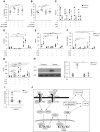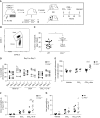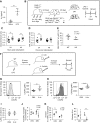IL4Rα Signaling Abrogates Hypoxic Neutrophil Survival and Limits Acute Lung Injury Responses In Vivo
- PMID: 30849228
- PMCID: PMC6635795
- DOI: 10.1164/rccm.201808-1599OC
IL4Rα Signaling Abrogates Hypoxic Neutrophil Survival and Limits Acute Lung Injury Responses In Vivo
Abstract
Rationale: Acute respiratory distress syndrome is defined by the presence of systemic hypoxia and consequent on disordered neutrophilic inflammation. Local mechanisms limiting the duration and magnitude of this neutrophilic response remain poorly understood. Objectives: To test the hypothesis that during acute lung inflammation tissue production of proresolution type 2 cytokines (IL-4 and IL-13) dampens the proinflammatory effects of hypoxia through suppression of HIF-1α (hypoxia-inducible factor-1α)-mediated neutrophil adaptation, resulting in resolution of lung injury. Methods: Neutrophil activation of IL4Ra (IL-4 receptor α) signaling pathways was explored ex vivo in human acute respiratory distress syndrome patient samples, in vitro after the culture of human peripheral blood neutrophils with recombinant IL-4 under conditions of hypoxia, and in vivo through the study of IL4Ra-deficient neutrophils in competitive chimera models and wild-type mice treated with IL-4. Measurements and Main Results: IL-4 was elevated in human BAL from patients with acute respiratory distress syndrome, and its receptor was identified on patient blood neutrophils. Treatment of human neutrophils with IL-4 suppressed HIF-1α-dependent hypoxic survival and limited proinflammatory transcriptional responses. Increased neutrophil apoptosis in hypoxia, also observed with IL-13, required active STAT signaling, and was dependent on expression of the oxygen-sensing prolyl hydroxylase PHD2. In vivo, IL-4Ra-deficient neutrophils had a survival advantage within a hypoxic inflamed niche; in contrast, inflamed lung treatment with IL-4 accelerated resolution through increased neutrophil apoptosis. Conclusions: We describe an important interaction whereby IL4Rα-dependent type 2 cytokine signaling can directly inhibit hypoxic neutrophil survival in tissues and promote resolution of neutrophil-mediated acute lung injury.
Keywords: IL-4; acute respiratory distress syndrome; hypoxia; hypoxia-inducible factor-1α; neutrophil.
Figures






Comment in
-
Chasing the "Holy Grail": Modulating Neutrophils in Inflammatory Lung Disease.Am J Respir Crit Care Med. 2019 Jul 15;200(2):131-132. doi: 10.1164/rccm.201902-0333ED. Am J Respir Crit Care Med. 2019. PMID: 30865833 Free PMC article. No abstract available.
-
Promoting Neutrophil Apoptosis to Treat Acute Lung Injury.Am J Respir Crit Care Med. 2019 Aug 1;200(3):399-400. doi: 10.1164/rccm.201903-0707LE. Am J Respir Crit Care Med. 2019. PMID: 31046406 Free PMC article. No abstract available.
References
-
- Galdiero MR, Bonavita E, Barajon I, Garlanda C, Mantovani A, Jaillon S. Tumor associated macrophages and neutrophils in cancer. Immunobiology. 2013;218:1402–1410. - PubMed
-
- Garlichs CD, Eskafi S, Cicha I, Schmeisser A, Walzog B, Raaz D, et al. Delay of neutrophil apoptosis in acute coronary syndromes. J Leukoc Biol. 2004;75:828–835. - PubMed
-
- Uddin M, Nong G, Ward J, Seumois G, Prince LR, Wilson SJ, et al. Prosurvival activity for airway neutrophils in severe asthma. Thorax. 2010;65:684–689. - PubMed
Publication types
MeSH terms
Substances
Grants and funding
LinkOut - more resources
Full Text Sources
Molecular Biology Databases

